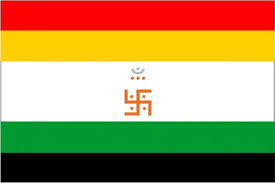Jain Flag
Introduction
Flags have always held a special place in various cultures around the world. They symbolize identity, pride, and unity. Jainism, one of the ancient religions of India, also has a flag that carries deep spiritual and cultural significance. In this article, we will explore the rich history, symbolism, and contemporary relevance of the Jain flag.
History of the Jain Flag
The Jain flag’s origins are deeply rooted in the ancient traditions of Jainism. While the exact timeline of its creation is hard to pinpoint, it is believed that the flag has been in use for centuries, evolving in its design and meaning over time. Initially, it was used in religious rituals and ceremonies, but its importance grew as Jainism spread across different regions.
Significance of the Jain Flag
In Jainism, symbols play a crucial role in conveying religious teachings and values. The Jain flag is no exception. It represents the five main vows that every Jain follows: non-violence, truth, non-stealing, celibacy, and non-possessiveness. The flag is a constant reminder of these core principles, especially during festivals and religious gatherings.
Colors of the Jain Flag
The Jain flag is a vibrant combination of five colors, each holding its own spiritual significance:
- White: Represents purity and peace.
- Red: Symbolizes the teachings of Jainism and the ascetics who follow them.
- Yellow: Stands for the souls who have achieved liberation (moksha).
- Green: Denotes the teachings of the Tirthankaras.
- Blue: Represents the universe.
Together, these colors encapsulate the essence of Jainism, reminding its followers of the path to spiritual enlightenment.
Design and Structure
The Jain flag is a simple yet powerful design. It is divided into five horizontal stripes, each in one of the five colors mentioned above. At the center of the flag, there is often an emblem that includes the swastika, a symbol of auspiciousness and good fortune, and the hand with a wheel on the palm, representing Ahimsa (non-violence).
Jain Flag in Modern Times
Today, the Jain flag is more than just a religious symbol. It is used in various contexts, from religious ceremonies to educational initiatives. Jain communities worldwide proudly display the flag during festivals, parades, and other events, fostering a sense of unity and cultural pride.
Comparisons with Other Religious Flags
While many religions have flags that represent their beliefs, the Jain flag stands out due to its unique combination of colors and symbols. Unlike other religious flags that may focus on a single emblem or color, the Jain flag’s multi-colored design reflects the diversity and inclusiveness of Jain teachings.
Creating Awareness About the Jain Flag
Efforts to promote understanding and respect for the Jain flag are ongoing. Educational programs and social media campaigns help spread awareness about its significance and proper use. These initiatives aim to ensure that the flag is respected and cherished by both Jains and non-Jains alike.
Jain Flag in Art and Culture
The influence of the Jain flag extends into art and culture. Many Jain temples feature the flag in their architecture and decorations. Artists often incorporate the flag’s colors and symbols into their work, creating pieces that celebrate Jain heritage and spirituality.
Respect and Etiquette
Handling the Jain flag with respect is of utmost importance. Guidelines for displaying the flag include ensuring it is clean, not letting it touch the ground, and handling it with care. During festivals and ceremonies, the flag is often raised and lowered with great reverence, reflecting its sacred status.
Global Influence
The Jain flag has a significant presence in global Jain communities. It is a common sight at international Jain conferences and events, symbolizing the unity and shared beliefs of Jains worldwide. The flag serves as a beacon of Jain identity, no matter where it is displayed.
Jain Flag and Identity
For Jains, the flag is more than just a piece of cloth; it is a symbol of their religious and cultural identity. It represents their commitment to the principles of Jainism and serves as a source of inspiration in their daily lives. The flag is often displayed in homes and businesses, reinforcing the values it stands for.
Challenges and Controversies
Like many religious symbols, the Jain flag has faced challenges over the years. Misuse or misrepresentation of the flag can lead to controversies, prompting efforts to educate people about its proper use. Preserving the integrity of the flag is essential to maintaining its significance and respect.
Future of the Jain Flag
Looking ahead, the Jain flag is expected to continue evolving in its symbolism and usage. As Jain communities grow and adapt to changing times, the flag will likely take on new meanings while retaining its core principles. Its role in promoting Jain values and unity remains as important as ever.
Conclusion
The Jain flag is a powerful symbol of Jainism’s rich heritage and spiritual teachings. From its historical origins to its contemporary relevance, the flag encapsulates the essence of Jain beliefs and values. By understanding and respecting the Jain flag, we honor the timeless principles it represents.
FAQs
What is the significance of the colors in the Jain flag? The colors represent purity, teachings of Jainism, liberated souls, teachings of Tirthankaras, and the universe, each carrying deep spiritual meaning.
How is the Jain flag used in festivals? The Jain flag is displayed prominently during festivals, parades, and religious ceremonies, symbolizing unity and spiritual dedication.
What are the guidelines for respecting the Jain flag? The flag should be kept clean, not allowed to touch the ground, and handled with care, reflecting its sacred status.
How has the Jain flag evolved over time? The Jain flag has evolved in design and meaning, adapting to the changing contexts while retaining its core principles.
Where can one see the Jain flag displayed? The Jain flag can be seen in temples, during religious festivals, international Jain conferences, and in homes and businesses of Jain followers.











